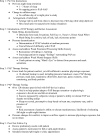A daytime, abbreviated cardio-respiratory sleep study (CPT 95807-52) to acclimate insomnia patients with sleep disordered breathing to positive airway pressure (PAP-NAP)
- PMID: 18595433
- PMCID: PMC2546453
A daytime, abbreviated cardio-respiratory sleep study (CPT 95807-52) to acclimate insomnia patients with sleep disordered breathing to positive airway pressure (PAP-NAP)
Abstract
Study objectives: To assess the impact of a daytime sleep medical procedure--the PAP-NAP--on adherence to positive airway pressure (PAP) therapy among insomnia patients with sleep disordered breathing (SDB) METHODS: The PAP-NAP is based on Current Procedural Terminology (CPT) codes and combines psychological and physiological treatments into one procedure, which increases contact time between SDB patients and polysomnography technologists to enhance PAP therapy adherence. Using a Sleep Dynamic Therapy framework, explicating SDB as a mind-body disorder, the PAP-NAP includes mask and pressure desensitization, emotion-focused therapy to overcome aversive emotional reactions, mental imagery to divert patient attention from mask or pressure sensations, and physiological exposure to PAP therapy during a 100-minute nap period. Patients treated with the PAP-NAP test (n = 39) were compared to an historical control group (n = 60) of insomnia patients with SDB who did not receive the test.
Results: All 99 insomnia patients were diagnosed with SDB (mean AHI 26.5 +/- 26.3, mean RDI 49.0 +/- 24.9), and all reported a history of psychiatric disorders or symptoms as well as resistance to PAP therapy. Among 39 patients completing the PAP-NAP, 90% completed overnight titrations, compared with 63% in the historical control group; 85% of the nap-tested group filled PAP therapy prescriptions for home use compared with 35% of controls; and 67% of the nap-tested group maintained regular use of PAP therapy compared with 23% of the control group. Using standards from the field of sleep medicine, the nap-tested group demonstrated objective adherence of 49% to 56% compared to 12% to 17% among controls. All studies were reimbursed using CPT 95807-52.
Conclusion: In this pilot study, the PAP-NAP functioned as a brief, useful, reimbursable procedure to encourage adherence in insomnia patients with SDB in comparison to an historical control group that did not undergo the procedure.
References
-
- Weaver TE. Adherence to positive airway pressure therapy. Curr Opin Pulm Med. 2006;12:409–13. - PubMed
-
- Golay A, Girard A, Grandin S, et al. A new educational program for patients suffering from sleep apnea syndrome. Patient Educ Couns. 2006;60:220–7. - PubMed
-
- Aloia MS, Di Dio L, Ilniczky N, Perlis ML, Greenblatt DW, Giles DE. Improving compliance with nasal CPAP and vigilance in older adults with OAHS. Sleep Breath. 2001;5:13–21. - PubMed
-
- Likar LL, Panciera TM, Erickson AD, Rounds S. Group education sessions and compliance with nasal CPAP therapy. Chest. 1997;111:1273–7. - PubMed
-
- Lewis KE, Bartle IE, Watkins AJ, Seale L, Ebden P. Simple interventions improve re-attendance when treating the sleep apnoea syndrome. Sleep Med. 2006;7:241–7. - PubMed
MeSH terms
LinkOut - more resources
Full Text Sources
Medical
Research Materials

